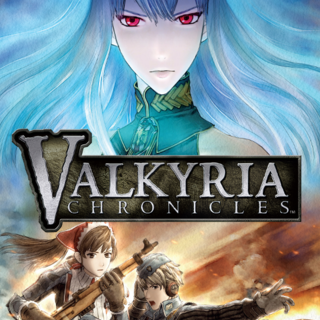INTRO:
Ever since Fire Emblem debuted on the NES, there has been a niche for so-called turn-based “strategy RPGs” in Japan. This sub-genre has waxed and waned over the years, but it has evolved to include some interesting takes on gameplay elements which are usually seen in Western turn-based strategy titles.
However, for better or worse, Japanese turn-based tactical/strategy games have something which their Western counterparts lack: story-telling that is sometimes so intense to the point of being campy.
Valkyria Chronicles is all of the above. Still, if the player can be patient with the typical anime story-telling in this Sega title, there is quite a lot of enjoyment to be had from it.
PREMISE:
Valkyria Chronicles takes place in what appears to be a fictitious version of Central Europe, specifically the Teutonic region. To the east, a seemingly resource-greedy Empire has a vast armed and armoured force, which it, predictably, has decided to use against its neighbours in order to seize even more resources.
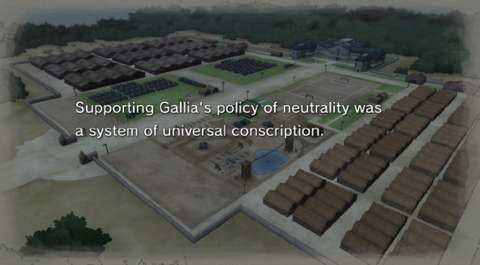
One of its neighbours is Gallia, a small country that so happens to have considerable deposits of one of the most coveted resources, a crystalline power source known as “Ragnite”. The Empire’s blitz was not entirely unexpected, but the powerful Empire still managed to drive deep into Gallia due to the incompetence of its high command.
However, that was before Gallia’s considerable militia army began to dig in and hit back. The player so happens to follow the struggle of one unit of this army, led by a tank commander by the name of Welkins Gunther and his friend and subordinate, Alicia Melchiott. As the campaign progresses, they learn more about the motivations of the Imperial army’s commanders and the secrets of Gallia itself, as well as those of their own.
PROLOGUE/TUTORIAL:
Valkyria Chronicles makes use of its prologue in order to deliver the tutorials and introduce the main characters, though the prologue emphasizes the latter more than it does the former.
Through a series of events that would have the two protagonists’ hometown overrun by Imperial forces, the player would learn how to make use of the capabilities of the soldiers who are under Welkin’s command. This would be alright for a player who is playing the game for the first time.
Unfortunately, for anyone else, such as players who want to replay a tutorial level to get a better performance record, the tutorial instructions cannot be skipped in their entirety. The player will have to mash on the skip button to get past each and every text bubble which pop ups during a mission, if he/she restarted the level from scratch. The player can circumvent this by making a game-save after all those instructions, but this is merely a work-around for a design oversight that should have been there in the first place.
At the very least, due to the structuring of the story-telling, the player can choose to skip past any story-telling cutscene after it has been played at least once.
MANUAL:
There are, unfortunately, a few things that the in-game tutorials do not inform the player about Fortunately, the game’s manual – which can be freely downloaded from its Steam store page – fills the gap.
For example, the tutorials do not mention how to have a character walk instead of run. The manual, however, does, via a visual mapping of the control inputs in one of its pages. More importantly, the manual mentions a feature to customize the control inputs for the game via a complementary program.
ENGLISH SUBTITLES NOT MATCHING JAPANESE VOICE-OVERS:
There would be players who are well aware that the English dubbing for the game is not exactly the most bearable, as is often the case with the English dubbing of any Japanese game that has been localized for English-speaking countries. Therefore, they might just switch to the Japanese voice-overs instead of the default English ones – which would be wise, because the English voice-overs are rather over-acted.
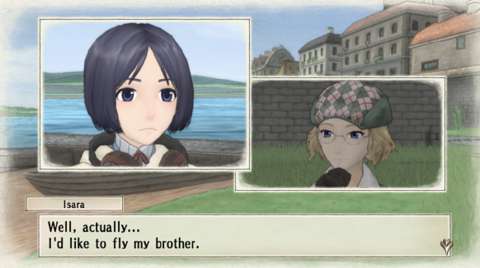
Unfortunately, the English subtitles do not always the Japanese voice-overs. Admittedly, this reviewer’s understanding of Japanese is limited. Yet, it is enough to notice the mismatches.
For example, very early on, one of the main characters would accost another main character, on suspicions that the latter is (somehow) a spy for having made sketches of freshwater fish. The latter would ask who the former is, with rather carefree warmness; in the subtitles, the former appeared to front her reply with a stark reminder that she is not there to make friends, before stating which unit she is with. Yet, the Japanese voice-overs sound like she is merely stating that she is with her border watch unit, without the reminder.
In fact, many of the subtitles – and the English voice-overs – may come off as off-putting and even tactless at times.
STORY CUTSCENES & TYPICAL ANIME CAMPINESS:
Progress in the campaign is depicted via cutscenes. The player will have to watch most of these in order to advance. Technically, this should not be an issue. After all, it would be justifiable that there should be some exposition to set up the premise for the next combat scenario.
Unfortunately, the cutscenes are not likely to please anyone who is not already an anime-watching veteran. There is copious cheese and camp to be had from the videos, and to a jaded story-goer, more than a little unnecessary dialogue.
Of course, most custscenes set up the backstory of the characters and give them opportunities to express their personalities; the ones which the game tags as optional side stories are even more so.
However, the fulfillment of function is not the same as the quality of delivery. In both the English and Japanese voice-overs, there is considerable over-acting, especially for scenes which involve the more energetic characters. For characters who are supposed to be used to the vagaries of war, they seem to be more melodramatic than they should be.
Players who are versed in war strategies would question the set-ups of the premises for some scenarios too. One example occurs early on, when two particular main characters engage a supposed recon party of Empire soldiers. If the Empire soldiers are supposed to be recon parties, they would have been stealthier at their task, instead of shooting civilians willy-nilly and tossing grenades; rather, this scouting party acted more like a terror squad.
The examples which have been given here are for the prologue sequences. There are even worse examples ahead.
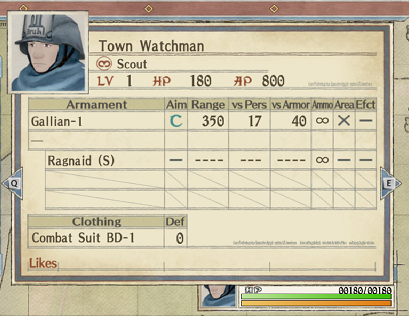
Still, the cutscenes do at least go some way to convey some apparent plot points and themes, in particular the sobering reality that people die in wars and that despite having a common cause, there may be politicking even among the ranks of militaries. That the main characters’ combat unit is a squad of drafted militia happens to facilitate this delivery.
(Side note: Players who have trivial knowledge of unit organization in professional militaries might notice that the main characters’ combat unit is more of a platoon than a squad, especially considering that it is a combined-arms unit. This might be due to shortfalls in the English adaptation.)
DIALOGUE SCENES:
There are story-related scenes in the game where exposition is delivered not via pre-rendered videos, but rather animated ‘portraits’ and voiced-over textboxes. Like the cutscenes, the player will have to go through these in order to advance in the story.
These are a bit better than the video cutscenes where it comes to keeping the campiness toned down, mainly because of the much-reduced presence of body language (which is just as exaggerated as the voice-overs).
Yet, consequently, these dialogues scenes happen to highlight the incongruence between the English subtitles and the Japanese voice-overs, even more so than the cutscenes. Granted, the subtitles are the result of attempts at adapting the original Japanese dialogue to English, so lingual nuances that are endemic to the Oriental language but not to English would be inevitably lost. Yet, to players who have read works of fiction which are of higher caliber, the English subtitles would still seem cringe-worthy.
Furthermore, unlike the cutscenes, not all of the dialogue scenes can be skipped in their entirety. The ones which occur in the completely story-based episodes can be skipped by pressing a button, but the ones which occur during combat operations cannot. For the latter, the player will need to mash on the skip button to get past each and every line of dialogue.
COMBAT OPERATIONS – OVERVIEW:
“Combat operations” is the name given by the game for the objective-based scenarios in the game, otherwise known as “missions”. These combat operations can be categorized into two overarching types: “episode” operations and “skirmish” operations.
The former are story-based, which is of course to be expected since the tale in Valkyria Chronicles is a tale of war and its travails. What is not as expectable though is their limitation, which will be described later.
The latter are repeatable, a design which is meant to allow the player to farm XP and Ducats (more on these later) so as to power up the combat unit’s soldiers.
Regardless of their design intention, any combat operation tosses the player into a turn-based battle against a computer-controlled opponent. The compositions of the opposing forces are asymmetric; more often than not, the opposing side is already occupying important locations and has more soldiers and war machines on the ground than the player could ever have.
The player will have to study the terrain and the locations of enemies, so as to find opportunities for advantageous positioning or a path to the objective with the least risk. The player will be doing this by consulting the (often inadequate) map and using characters to perform reconnaissance.

Any strategy that the player uses is likely to involve eliminating at least one enemy. There are a few ways to do so, as will be described later, but shooting them is the most obvious. In this matter, the game uses a hybrid system of manual aiming and RNGs to determine the scattering of the shots. This will be described further later, yet it will have to be said for now that a little luck is involved in this part of the gameplay, though planning is still a more significant factor.
Not every enemy has to be killed, and there are limited incentives to kill every enemy too. The objective of any scenario is of more importance, and striving to achieve it is often the most efficient way to complete a combat operation.
On paper, these combat scenarios are neither excitingly new nor inherently flawed. Yet, the devil is in the details; these will be described in the following sections.
ONE-SHOT STORY-BASED COMBAT OPERATIONS IN REGULAR “NEW GAME”:
As mentioned earlier, a number of the combat operations are associated with the story, and must be played in order to progress in the story. After the player has completed them, they cannot be re-attempted again.
This would not be an issue if there is nothing that cannot be obtained elsewhere in these scenarios. Unfortunately, there are: there are “ace” enemies who happen to carry special equipment that cannot be obtained in any way other than to kill them. In fact, a player would not know about the presence of these “ace” soldiers if he/she had neither scouted the map thoroughly nor resorted to looking at a guide.
After the player has started a “New Game Plus” playthrough, this limitation would be alleviated; story-based combat operations can be re-attempted, just like skirmish scenarios, so the player can hunt down these aces as much as they like while trying to obtain A-rank performances, if they have not already.
However, for players who are in their first playthrough, they will have to reload an earlier game-save and continue from there if they want to re-attempt a completed story-based operation.
Unfortunately, resorting to this work-around also reveals another design limitation that may not sit well with every player.
LIMITED GAME-SAVE SLOTS:
For better or worse, one of the characteristics of Japanese-designed video games is that there is a deliberate limit on the number of save-game slots. When they are ported over to the computer platform, this limitation is not always removed; this is the case with Valkyria Chronicles. Therefore, the player will need to overwrite earlier saves if he/she wants to make newer ones later.
As mentioned earlier, the only way that a player can replay completed story-based combat operations is to reload an earlier game-save. Yet, the player can run the risk of losing this ability if he/she has inadvertently overwritten this game-save.
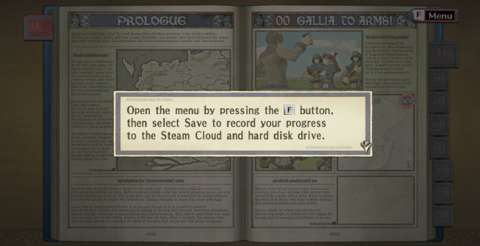
SKIRMISHES:
Skirmishes are combat operations which can be repeated as many times as the player likes. This is the game’s way of allowing the player to grind XP and ducats to spend on troops and hardware development. If the skirmish operations which are to be repeated happen to have “ace” enemies too, they can be killed over and over so that they repeatedly yield special guns.
Eventually, a cunning player will figure out how to complete skirmish scenarios in efficient ways, typically by exploiting gaps in the positioning of enemies and exploiting the advantages of specific soldier classes.
It should also be mentioned here that most, if not all, of the skirmish maps appear to re-use the maps in the story-based combat operations; this observation also extends to the skirmish maps in the DLC packages. The only differences which they have are the composition and positions of enemies. This can seem a bit lazy.
Speaking of the composition and positions of enemies, these are determined by the difficulty setting which the player has picked before starting a skirmish. The “Easy” setting obviously poses the least challenge, whereas the “Normal” setting will populate the map with more powerful enemies. There are higher difficulties, but they are only available in “New Game Plus” mode.
The DLC for the game also introduces special skirmish maps which are oriented around the use of a specific class of characters. These will be described later in their own section.
CHARACTERS IN COMBAT:
The majority of combatants in combat operations are implemented as characters with statistics such as the all-too-familiar hitpoints and defense.
Combatants on foot can move about on the battlefield, either by running or walking; which movement method is used is actually quite important, as will be described later. For now, these appear to be the only options that they have; there does not seem to be any personnel carriers or troop transports which can ferry them around.
In his/her turn, a character can only move about so much. This limitation is expressed through the “Action Point” system, which will be described later.
Any soldier has one main hand-held weapon, be it a type of firearm or the lance (more on this later). This weapon defines a soldier’s battlefield role and determines which combat situations that he/she is most effective in. There can be more than one model for the type of gun that a soldier can use. The differences in the models are mainly statistical, however.

If a soldier is spotted by enemies and goes within range of their weapons, he/she will be shot at and will take damage. This is something that is not always preventable, because the player will need to advance troops into contested territory in order to seize it.
Therefore, knowing how much damage that a character can take will be important. It is also important to know that no matter how many hitpoints that a character has, he/she generally performs at the same level as when he/she would at full health. That is, unless that character has a personality quirk which causes otherwise. (Speaking of which, personality quirks – called “potentials” in-game – are a significant gameplay element that will be described further later.)
Characters can be taken out of battle, usually by getting knocked out. They are not dead yet, but they will be if their comrades do not something to rescue them. There will be more explanation on the system of casualties later.
FIGHTING VEHICLES:
Footsoldiers are not the only ones mucking about in the battlefield. Thanks to the miraculous properties of the aforementioned energy source Ragnite, there are also tanks which rumble about to deal death to anything which is stupid or bold enough to get in their line of fire.
However, fighting vehicles have a difference in their rules of movement which severely curtails their mobility. For one, turning also expends Action points. This means that their owning player must keep their facing in mind before they run out of Action Points or end their turn, lest they get bypassed or flanked.
All vehicles have one thing in common; they have glowing radiators which jut out of somewhere on their chases, usually the rear. Due to the vagaries of Ragnite technology, these are needed in order to bleed off excess heat from the engines of the vehicles. Gameplay-wise, they are, of course, the vehicles’ weak points; any weaponry with enough damage against armor will do substantially more damage if they hit the radiators.
Veterans of tactical games involving tanks might want to know that there is no mechanism of different front, side and top armour ratings. Any attack which hits an armored vehicle anywhere other than their radiators or treads will do the same damage.
Fighting vehicles are not stopped by light obstacles, such as crates and wooden fences. Rather, they just plow through these, thus clearing the way for footsoldiers to move through.
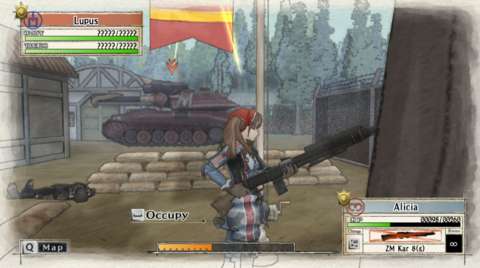
There is an assortment of opposing vehicles that the player will have to fight; the Imperials are, after all, the ones who invented tanks. In contrast, the player appears to only have the Edelweiss for the first half of a playthrough, and another tank for the rest. Even so, the player’s vehicles will often be outnumbered by opposing vehicles.
This, of course, requires the player to be more careful and make better use of footsoldiers. Unfortunately, there are problems which trouble the use of the player’s tanks. These problems will be described later.
OVERWATCH FIRE:
Although the game does not name it as such, there is the gameplay element of “overwatch” fire. It is called “intercept fire” or some other variation of this phrase by the English adaptation, but veterans of shooting-oriented turn-based strategy games would recognize it as it is when they see it.
In Western turn-based strategy games, “overwatch” fire is any attack that members of the opposing side can make against members of the side which is currently having its turn. Generally, this gameplay element is used as a painful reminder that members of the side which is having its turn can still suffer opportunistic attacks from the other side.
However, in the Western titles, the opposing side can only fire so many overwatch shots, meaning that the player can still use tough units to trigger and absorb overwatch fire, or just sacrifice some expendable troops if the player is unscrupulous enough to do that.
This is where Valkyria Chronicles differs from those titles; the opposing side can continuously fire overwatch shots as long as their target is within their arc and range of fire. This means that the player should keep in mind the locations of any cover pieces that the currently-controlled unit can use in order to avoid taking too much overwatch fire.
A key aspect of the overwatch system is that the unit which is being currently controlled by the player, or the computer-controlled opponent, is the only one on his/her/its side that will be shot at by the enemy. Even if there are other enemies nearby, or even in plain view and within range, a unit which is firing overwatch shots will only shoot at an enemy unit which is being controlled by the opposing player.
This can be exploited in a few ways, such as causing enemy soldiers which are firing overwatch shots to turn towards the currently-controlled unit, thus exposing their backs to other enemies which are attempting to flank them.

OVERWATCH DETECTION:
There are rules which determine whether an opposing unit has spotted a unit which is being controlled; overwatch shots can only be fired at a unit if it has been spotted.
In the case of soldiers, they will detect anyone which comes within a 180-degree arc in their front facing and will continue to track this person, including turning in order to shoot overwatch shots if they can. They will also detect any enemy who gets too close, regardless of their facing. (Not every soldier can fire overwatch shots; there will be explanation about this later when soldier classes are described.)
Soldiers on the same side can also share the results of their detection with each other. This means that soldiers on the same side can watch each other’s blind spots. However, this also means that they will then focus their attention on the same target, which is a behavior that can be exploited in order to have them look at any way other than at an opposing soldier who is trying to sneak past them.
In the case of vehicles, their arcs of detection depend on their structural design. For example, for the Edelweiss, it has a narrow arc of detection from its front facing. Therefore, it is only effective at covering narrow corridors. The other vehicles in the game have different detection arcs, though the player will not be informed about these via any in-game tips.
Regardless, vehicles cannot turn their entire hulls in order to track a target, which means that they can be snuck by if the player is wily enough to figure out their blind spots.
ACTION POINTS:
“Action points” govern how much a unit can move when it is chosen to act (there will be more on choosing units for action later). These are shown via a meter at the bottom of the screen; the length of the meter is proportional to the number of Action Points which a unit has, which in turn depends on the class of the unit.
Crouching into cover and standing out of cover does not deplete the action meter, which is perhaps a bit understandable as these are fast motions. Climbing onto higher platforms – which is not animated – does not deplete the action meter either. The latter can seem rather odd, because these should be rather involved tasks.
The speed of movement of a unit is a gameplay element that is independent of action points. For example, snipers have the least action points, but they move a bit faster than shock-troopers, which have more action points than they do.
When the player decides to end a unit’s turn, he/she will be given a prompt to do so. This prompt also happens to force any enemy that is firing overwatch shots to return to their default pose; this can be exploited in order to reset their aiming animations. However, shooting animations cannot be stopped; shots will still be fired before the enemy unit resets its pose.
Oddly enough, having a soldier run in place does not reduce action points; they will only be consumed if the soldier has moved a clear lateral distance. This is just as well, because there are problems with the collision hitboxes of environmental objects that are a bit mitigated by this design limitation; this will be described shortly.
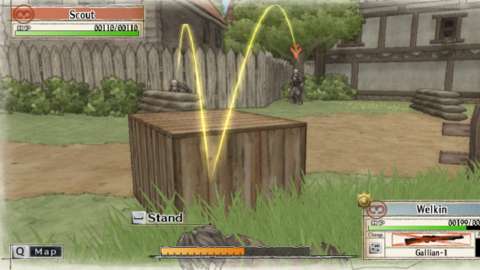
IFFY ENVIRONMENTAL OBJECTS:
Moving around a battlefield in Valkyria Chronicles can be problematic. This is due to the unpredictable difficulty of navigating around or over objects in the environment, at least for a first-time player.
For example, a soldier can run over most rubble, but only as long as the rubble is modeled as a dome-like pile. Any other kind of rubble, especially that which juts out like jagged rocks from the ground, will block the movement of soldiers, even if they are barely a foot high and should have been negotiable by human feet and legs.
Another example is ramps. Although the player will see soldiers vaulting over sandbags and climbing out of trenches, they cannot step onto a ramp which is just a foot high from where they are; the same applies to stairs. The player must have them run around to the beginning of the ramp or stairs. Likewise, the player can have soldiers dropping into trenches or dropping off buildings, but cannot have them walk off certain stairs or ramps.
For a new player, these inconsistencies can lead to a lot of wasted time and action points.
SHOOTING – OVERVIEW:
Being a game with a continental war as its setting, Valkyria Chronicles expectedly has the player doing a lot of shooting.
For the purpose of shooting, there is what the game calls “Target Mode”, which can be triggered at any time when a character or vehicle is under the player’s control. It can even be triggered when the unit no longer has any Action Points remaining. Furthermore, having made an attack already, the unit can still use its remaining action points to move about. For example, a soldier can make a shooting attack and then withdraw to duck behind cover, thus ending his/her turn behind some protection.
Both of these conveniences make Valkyria Chronicles quite different from many other turn-based strategy games, which usually end a unit’s turn once it has made a significant action, such as attacking.
For better or worse, the outcome of shooting depends on a mixture of RNG-rolling and collision detection. Firstly, a unit’s accuracy is depicted by a circular aiming reticle; his/her/its shots will land on any location within this reticle with a Gaussian probability distribution that is maximized around the center. If a shot appears to touch the model of the target, it is considered to be hit.
Yet, this also means that bad luck can have a player missing a target by a hair’s breadth if it is not completely within the reticle. This can be infuriating when it happens.

If the player wants to reliably hit something, he/she will need to have the soldier or vehicle to approach its target such that more of the latter fills the targeting reticle. This is easier said than done, of course, due to the aforementioned overwatch system.
Fortunately, the player still gets rewarded for getting closer to the target. This is because the damage which can be inflicted on a target is also dependent on the distance between the target and the shooter; longer distances mean that any landed shots do less damage, i.e. there is damage fall-off. The damage fall-off appears to occur for distances which are more than half the effective range of the weapon which is being used. There are a few weapons which do not have damage fall-off, however; chief of these is the sniper rifle.
Almost every target has a weak point, which when hit, inflicts additional damage. In the case of soldiers, this weak point is invariably their head or helmet, both of which are considered one and the same. In the case of vehicles, these are their radiators, which are often located at their rear and glow a very obvious lightning-blue.
These are the most basic gameplay designs of shooting. There are certain other gameplay-affecting nuances about it, but these are associated with the visual designs and will be described together with the latter.
PROBLEM WITH LEARNING ABOUT VEHICLE FIRING ARCS:
Armored fighting vehicles are buttoned-up war machines. Therefore, they do not have a full 360-degree firing arc, and any arcs which they have cannot be rotated in their entirety during the opposing side’s turn. Therefore, if the player knows the extent of their firing rates, he/she can have his/her own tanks holding down corridors or have footsoldiers sneak about the blind spots of enemy tanks.
Unfortunately, there are not many in-game tools or features which help the player familiarize himself/herself with the firing arcs of vehicles. The player will likely to have learn things the hard way, e.g. discovering that the rear machinegun turret of an Imperial medium tank has an arc of fire which is actually wider than 180-degrees after having a soldier come under fire.
GUN DEPRESSION:
The gun turrets of fighting vehicles, including their machinegun turrets, have limited depressions. This means that a tank can actually do little to defend itself if a footsoldier can saunter up to it and stay close to its body, especially if its gun turrets are mounted on the top of its hull. Of course, the footsoldier will have to be quite short in stature; tall soldiers are likely to get shot in the head instead.
Fortunately, footsoldiers are not affected by limitations in gun depression, at least not by much. They can point up to 70-degrees downwards from the horizontal.

PARTNERED SHOOTING:
When a soldier makes an attack on an enemy, any comrade who is nearby will contribute his/her fire as well, assuming that he/she is armed with a weapon that can do so. This is important to keep in mind because this combined fire is often an effective way to eliminate a tough or entrenched enemy in that soldier’s turn.
However, in practice, setting up partnered fire can be difficult to pull off without incurring opportunity costs. The player may be better off having soldiers cover more ground in preparation for maneuvers in the later turns, instead of having them end their moves close to each other and forfeit any remaining action points. Still, the option is there, in case there is a tough enemy which the player wants removed as soon as possible.
BEHAVIOR OF SURVIVING TARGETS:
Observant players will notice that soldiers who survive shooting attacks automatically detect their attacker. They will then turn towards their attacker; this behavior can be exploited for some cunning tactics.
For example, a wily player might deliberately waste a soldier’s allowance of an attack on an enemy soldier in order to have that enemy soldier turn away from the player’s other soldiers, who may be able to sneak around behind them (or more likely, gain an opportunity to shoot them in the back).
If a soldier survives a shooting attack by an enemy, the soldier will make a retaliatory attack if he/she is of a particular soldier class which can do so and the enemy is within range of his/her weapon.
This mechanism of retaliation would keep the player on his/her toes, especially if he/she is banking on being able to keep an enemy with one volley at close range.
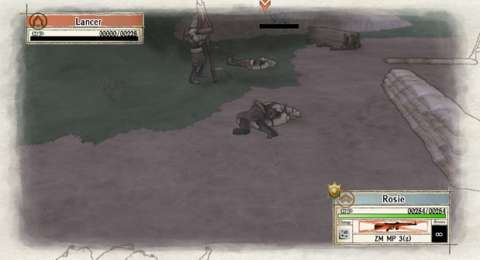
MAGAZINE SIZE & VOLLEY SHOTS:
Most firearms have magazines, but these magazines do not exactly work as part of a system of ammunition management. Rather, magazine sizes determine how many shots that a gun fires when its wielder makes an attack with it.
This can seem a bit unseemly to players who are used to games with ammunition management, but in Valkyria Chronicles, ammunition management is rather simplified; this will be elaborated further later.
Each shot from a weapon has its own scatter roll, but shares the same damage output as the other shots. Guns which dump large numbers of shots may have higher damage output than other variants of guns of the same type, but they tend to have poorer accuracy, i.e. bigger reticles.
EVASION:
Any footsoldier has an evasion rating, which is the probability that they will drop prone just before any attacker makes an attack on him/her. This is of course a luck-dependent matter, but there are other factors which determine whether the evasion-rating will come into effect or not.

For one, evasion animations will not trigger if a footsoldier is attacked from behind. This is where the player can attempt to exploit the overwatch behaviours of enemies for his/her own advantage. The player can have a soldier draw the fire of enemy troops, thus causing them to turn their bodies in order to shoot. The player can then use another soldier to shoot at their backs.
Explosive weapons, such as grenades and mortars, will trigger evasion animations too, but only if they land within the target’s field of view. In this case, they will take a lot less damage and are not tossed around either.
A soldier may perform an evasion animation, but he/she can still be hit if shots landed on their prone bodies. However, they take greatly reduced damage if this happens.
Different soldiers have different evasion ratings. Scouts appear to have better evasion ratings than most other classes, for example. However, the characters with the greatest evasion capabilities are enemy Aces. A wise player would often find a way to unceremoniously kill Aces, e.g. shooting them in the back.
HIGH PLATFORMS:
In some maps, there are structures which allow soldiers to shoot from higher elevations. These are usually watchtowers and sometimes medieval rampart turrets. However, only one soldier may occupy such a platform at any time.
Being on such a platform appears to increase the range of the soldier’s weapon, in addition to giving him/her a better angle of firing that goes over any cover which might be obscuring the target. This can be incredibly useful for snipers and lancers (assuming that the latter is armed with accurate lances).
Watchtowers can be destroyed. However, unless the enemy is already occupying them, there is little need to do so; in fact, it may be more advantageous to leave them intact so that the player can use them instead.
COVER PIECES - OVERVIEW:
A battlefield would not be one if there are not any cover pieces to take advantage of. These should not be confused with obstacles that obscure line of sight or line of fire, though some cover pieces can do this too.
Making use of cover pieces is as simple as having a soldier approach and crouch close to them. When this happens, the soldier gains significantly increased defense and shots on their heads will not inflict critical hits. Nothing short of a tank shell can kill them in one hit if they have full health.
There are two major types of cover pieces in the game: sandbag walls and trenches.

SANDBAG WALLS:
The most common cover pieces are hip-high sandbag walls. Sandbag walls can be destroyed by tank-rams, as well as grenades and other explosive weapons, the latter of which can seem unbelievable since well-packed military sandbags are supposed to be capable of dissipating explosive blasts.
Anyway, this is something to keep in mind if the player encounters enemies who are crouching behind sandbags at locations which he/she needs to capture; destroying their sandbag cover makes them easier to kill afterwards, if the player cannot kill them outright with a single attack, e.g. a flamethrower burst.
TRENCHES:
Trenches are furrows which have been dug into the earth. They obviously cannot be destroyed, nor can they be deepened any further. Furthermore, since soldiers have to lower themselves into the trenches, they lower their profiles too and thus they are harder to hit. Trenches also block the movement of tanks, unlike sandbags, which are simply knocked aside. These advantages make trenches far more reliable cover than sandbags.
NUANCES & PROBLEMS WITH COVER PIECES:
Soldiers can vault over sandbags and trenches. This is an act which does not actually consume Action Points; indeed, it may be advantageous to plot a path through a network of sandbag walls so as to save on Action Points.
However, there is no dedicated button to go over sandbags and trenches. The player will have to hold down the forward button for slightly more than a second for the game to register the player’s desire to vault over cover.
Which side of a sandbag wall or trench that a soldier takes cover behind does not appear to matter much when this soldier is shot at by enemies. Even if the soldier is crouching in front of a cover piece in full sight of enemies, he/she still enjoys the benefit of the defense bonus provided by the cover piece. In other words, flanking does not appear to work against a soldier which is crouching behind cover. Of course, the soldier does not benefit from having the cover piece obscure his/her model, so there is that.
Soldiers in trenches can be tossed out of them by explosions. Although this might seem understandable, this is actually due to the consequences of the ragdolling animation and the scripts which are used to reposition the models of characters. A soldier may look like he/she has been thrown against the inner walls of a deep trench, only to be repositioned outside of the trench, thus losing their source of protection.
TANK-TRAPS:
As their name suggests, tank-traps are intended to block the movement of tanks. They are almost chest-high obstacles which can be used to obscure soldiers from the enemy’s line of fire. However, tank-traps cannot be used as cover in the way that sandbags and trenches can be.
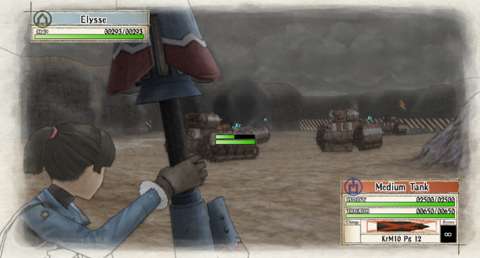
Some tank-traps can be destroyed with grenades and mortars, though it can be a bit difficult to know which can be destroyed. Their icons on the map will not show this. Instead, the player will have to rely on noticing the colour of the tank-traps: the grey-coloured ones can be destroyed, whereas the darker ones are indestructible.
Without having been informed by more experienced players or other third-party sources, it will be unpleasant for a player to learn about this the hard way.
CRATES AND OTHER WOODEN OBJECTS:
There are objects which can block the movement of footsoldiers but will not do much against tanks, which can just crash into them. These are typically crates and wooden fences, though there may be other objects depending on the map which is being played. If the player cannot have a tank crash through them, they can be destroyed with grenades and other explosive weapons; this opens up alternative routes.
For example, in one of the earlier screenshots in this review, specifically the one with the Imperial tank known as the Lupus, it is possible to sneak around the tank if the player can destroy some crates which are preventing passage into an alleyway that the Lupus does not cover.
CAMPS:
Camps are locations on the map which act as the staging points of either side. These are where either side brings in fresh units into the field from their reserves by spending CPs to summon them as reinforcements. In the case of the player, these are also where the player may send soldiers back into his/her reserves so that they can be re-deployed elsewhere.
In addition, any units which are lingering around the camps which are controlled by their side will benefit from bonuses to their statistics, the most prominent of which is improved health recovery over a turn.
Considering the usefulness of camps, it is in the interest of either side to attempt to capture and hold as many camps as possible. Incidentally, this is something that the generally lousy computer-controlled opponent will keep in mind better than it does any other strategic consideration. However, camps cannot be captured as long as the owning side has soldiers (or vehicles) in the camp’s zone of influence.
In most scenarios, the mission objective is to capture the base camp of the enemy, while simultaneously protecting the player’s own. Surprisingly, this is actually easier than one would think, mainly due to the lack of aptitude on the part of the computer-controlled opponent.
It should be noted here that units which have been called in as reinforcements onto camps will only arrive in next turn of their side. If the camps are captured before they can appear, the reinforcements are cancelled and any CPs which have been spent on calling them in are outright wasted.

INCAPACITATION & DEATH:
Valkyria Chronicles would not be a game about conflict if it does not have death, or at least some kind of mechanism to punish poor play on the part of the player.
This would be the incapacitation and/or subsequent death of soldiers. If a soldier’s health is depleted to zero, he/she is knocked out (usually with an outrageous ragdoll animation; this will be described further later). The player has only three turns to evacuate the soldier before either of the following occurrences: the three turns are up, or an enemy soldier reaches the incapacitated soldier.
Either occurrence results in the permanent death of the soldier. In the case of soldiers with unique faces and names, the player will be “rewarded” with death quotes and canned animations. Obviously, this is not in the player’s interest, unless he/she just wants to know what they would say (in this case, there are online videos which show exactly these). Primary characters such as Alicia, Largo and Rosie are, however, exempt from death.
The main way to rescue an incapacitated soldier is to reach him/her with another soldier (or the tanks). However, this means that the player may have to put the other soldier in the path of harm’s way and also waste the other soldier’s turn on doing this instead of something which contributes to the mission.
The other way is to spend CPs on Orders which can evacuate incapacitated soldiers, but again, this is an expenditure of CPs which would not have been necessary if the player has been more mindful of how he/she is at using the soldiers.
GAME-OVERS:
Game-overs occur if the mission-failure condition is triggered; this condition is handily labelled in red among the list of objectives. Generally, this is the capture of the player’s base camp by the enemy – something that can happen if the player has forgotten to leave behind a soldier (preferably a Shocktrooper) in order to guard the base camp.
Regardless of the unique conditions of any combat operation, there is one certainty whenever Welkin or the Edelweiss is around; if either is knocked out, it is a straight game-over.
Game-overs are the only way to return to the briefing and deployment phase of the current operation which is being played, without resorting to reloading an earlier game-save. This is not a good design; it would have been more convenient to provide the convenience of returning to the briefing or deployment phase at any time during an operation.
COMMAND POINTS:
As mentioned already, Valkyria Chronicles is a turn-based game. However, what have been described thus far up to now are game mechanisms which run in pseudo-real-time. The system of “command points” imposes turn-based rules on the gameplay.
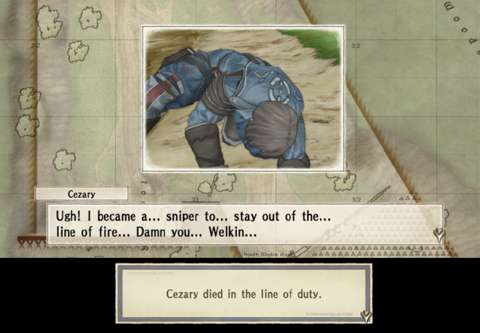
There are always two sides in each battle. Each side takes turns to make moves with its soldiers and war machines, and to limit how much either side can do in its turn, it is given a number of command points, which are depicted by the crests at the top of the screen.
These command points, or CPs for short, can be spent to “activate” a soldier or war machine for the player (or CPU-controlled player) to control; a soldier takes one CP, whereas a fighting vehicle takes two. For most of the game, a wise and cunning player would spend more CPs on footsoldiers than tanks, mainly because footsoldiers are always more mobile.
At the start of either side’s turn, it receives an income of CPs; the minimum incomes for both sides are equal. There are no ways to gain CPs during either side’s turn; CPs are always expended. On the other hand, either side can choose to reserve unused CPs, which can be brought over to the next turn. However, there is a maximum of 20 CPs which can be accumulated, and more is not always better, due to a deliberate balancing limitation that will be described shortly.
To prevent the player from spending too many command points on specific favored soldiers, there is a penalty which is applied on the action point reserves of a soldier (or tank) when more than one CP is used on him/her/it. To be precise, the action point reserves of a unit are reduced by a third for each CP after the first. The reserves will not go below 5%, however, so a unit can still be used over and over as long as the player still has the CPs to do so, which might be useful if the unit is at a strategic position which allows it to shoot effectively at multiple consecutive targets.
The player can increase the income of CPs for each turn by having soldiers which are considered as “officers” on the battlefield; these soldiers have CP crests next to their name labels. However, if they are knocked out, the player’s income of CPs is reduced on the next turn.
This penalty also applies to the computer-controlled opponent, so eliminating enemy officers or war machines with crests will be an important part of any effective strategy. Of course, this is easier said than done, because these enemies have a tendency to be tougher than most other enemy units.
COMMAND MODE:
“Command mode” is the user interface which the player uses to spend Command Points on units. It also shows the map of the level and the locations of units, both of the player’s and any enemy units which the player’s own forces have spotted.
Incidentally, the map which is shown in command mode is a lot clearer than the one which is shown during briefing. Specifically, it shows the location of trenches, obstacles, level boundaries and other objects with much clearer contrast than any other maps in the game.
ORDERS:
There is a system of buffs and fire support in the game that is described in-game as “Orders”. (This is stated in romaji in the Japanese voice-overs.) These are like mixtures of rousing speeches and actual instructions.
Anyway, the player can spend CPs on Orders instead of units, granting a unit – or all units in the case of orders which do so – bonuses to their statistics. For example, one of the most convenient Orders is the Defense Boost, which, as its name suggests, increases the defense rating of a unit.
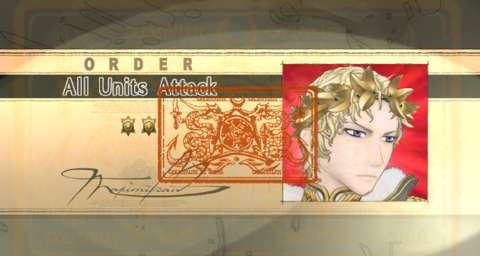
There are also Orders which can rescue the player’s units which have been incapacitated, though having to resort to these is usually a sign that the player has been making poor decisions.
Some orders are also offense-oriented. For example, there is Mortar Support, which can be used to apply artillery bombardment on a small area; conveniently, this area is bigger than most camps, so this Order can be used to clear or weaken the defenders of an enemy-held camp before the player saunters over to capture it.
It has to be emphasized here that the non-map-wide Orders can only be used on units, be it a unit under the player’s control or the enemy’s. This restriction is understandable in the case of Orders which buff the player’s units, but not so much for Orders which are to be used to harm enemy units. In the case of Orders which damage enemy units in an area, these must be centered on enemy units; the player cannot manually place the epicenter of the area anywhere else. This is a limitation that veterans of strategy games, especially those on the computer platform, may not find acceptable.
CLASSES – OVERVIEW:
There are several types of footsoldiers, each with its own role on the battlefield. Each will be described later in their own sections.
Next, there are the force multipliers, which are, of course, tanks. As to be expected of armoured fighting vehicles, they are proofed against small-arms fire, except where their radiators are. They are also armed with heavy weapons that can easily wreck infantry.
“EXP”, LEVELLING UP AND ‘ELITE’ STATUS:
Before describing each and every class, the gameplay elements which concern the progressive growth in strength and ability of soldiers will be remarked upon.
As the player completes operations successfully, the player gains experience points which can be spent to improve all soldiers of any class; the reason for this peculiar convenience is actually explained in-game.
As to be expected of a gameplay element which makes use of the ages-old mechanism of experience points, investing experience points into soldiers is a way to make them stronger. When a soldier type gains a level after having reached an experience threshold, all soldiers of the same type gains an increase in their hitpoints, and periodically in other statistics. However, the other statistics grow at a slower rate than hitpoints. Furthermore, a sizable portion of their combat performance is determined by the quality of the gear which they are using.
There is also another incentive to level-up soldiers: the unlocking of what the game calls “Potentials”. These are practically innate buffs and de-buffs that can be triggered when certain conditions are met. There will be a section on Potentials later.
Levelling up soldiers is also how the player obtains more Orders for Welkin to use. However, without having done research beforehand, a new player would not know which level yields an Order.
Upon reaching level 11, a soldier type turns into the elite version of itself and gains considerable statistical improvements, especially in their Action Point reserves; in the case of three classes, the change is particularly significant, as will be described later.

The player can choose to partially fulfill the requirement of experience points that is needed to achieve the next level for a soldier type. However, there does not seem to be any incentive to do so, so this convenience may seem unnecessary.
SCOUTS:
Scouts will be the clever player’s unit of choice for situations which involve the covering of ground in as short a time as possible. This is because of their comparatively vast reserves of Action Points.
They are more fragile than the Lancer and Shocktrooper, but this is a disadvantage that can be overcome with proper planning, such as having Snipers remove any enemy soldiers that is in the way of a Scout and using sight-obscuring obstacles as much as possible in order to improve a scout’s survivability. Unsurprisingly, Scouts will be crucial to A-rank performances.
Scouts become even more versatile when they reach elite status. When this happens, they gain a grenade launcher attachment for their rifles. This allows them to launch their otherwise hand-thrown grenades in a long and high arc, thus circumventing the cover of enemies. Unfortunately, the player will not be able to clearly see past obstacles which he/she wants to launch a grenade over, though the player can still wiggle the arc about until it ends on an enemy, upon which the colour of the arc changes.
SHOCKTROOPERS:
Shocktroopers are what the player needs if an effective strategy requires the player to forge a path through an avenue that is littered with enemies that are capable of pouring great amounts of overwatch fire. Shocktroopers have considerable defense ratings against anti-personnel weaponry, and most Shocktroopers have potentials which make them capable of weathering overwatch fire, all of which are incidentally anti-personnel.
Shocktroopers are also the only footsoldiers who wield full-auto fire-arms. Most of these guns may seem rather inaccurate and have severe range limitations, especially the Imperial ones, but they compensate by shooting many bullets.
However, the Shocktroopers’ most potent assets are their flamethrowers, which are available after they have achieved Elite status. These douse an arc in front of the Shocktroopers in flames, harming anyone who happens to be caught in them. The flamethrowers’ most important property is that they ignore any protection provided by cover, thus making Shocktroopers the default choice for assaulting any entrenched enemies.

ENGINEERS:
Engineers, like scouts, are armed with the standard issue rifle. However, this appears to be mainly there so that engineers are not completely helpless in combat. Performance-wise, they are weaker than scouts.
This is perhaps just as well, because Engineers are meant to play support roles. Firstly, as their name suggests, they are meant to keep tanks up and running, especially if they are away from the camps. Secondly, they happen to have the much more potent version of the ubiquitous Ragnaid healing device; if the player’s strategy hangs on having an important soldier being in tip-top shape, an engineer would come in handy. (The most efficient strategies do not include this consideration, however.)
Thirdly, the Engineer can replenish the consumable supplies of any other soldier and any tank by simply walking up to the latter; there is no limit to doing this. However, the Engineer cannot restore his/her own reserves of consumables, though the Engineer happens to have reserves which are greater than the others, such as up to three grenades to use instead of just one.
The Engineer is also the only soldier which can restore destroyed sandbag walls; this will be of particular use if the player needs to defend a critical location (typically the player’s base camp). More importantly, repairing sandbag walls and disarming mines do not consume the Engineer’s attack allowance. Wily players would consider this when planning the most efficient routes for Engineers.
Finally, the Engineer is also the only soldier which can disarm mines without resorting to a clumsy and very explosive solution (more on this later).
SNIPERS:
Snipers specialize at shooting the heads of faraway targets. Indeed, the best strategies to stymie the capabilities of the opposition often involve using Snipers to kill enemy officers from far away. However, to prevent the player from exploiting this main ability of Snipers, each Sniper can only fire up to three shots in his/her side’s turn (unless they have some Potential that allows them to regain ammo).
Unfortunately, Snipers are quite useless at doing anything else. Despite being lightly equipped, they have the least Action Points of all soldier classes; this runs counter to real-world military doctrines which require the sniper to be particularly mobile. Furthermore, they cannot fire overwatch shots.
LANCERS:
Lancers are the main anti-tank footsoldiers. Unfortunately, they are also the least versatile of all the soldier classes, mainly due to the fact that they only ever have their lances as weapons, and these certainly cannot fire overwatch shots.
Most of the Gallian-produced lances have rather poor accuracy, thus requiring Lancers to get rather close to their targets if they want to hit the latter’s weak spots. In fact, astute players would realize that it is easier to have more mobile soldiers who are armed with powerful rifles or machineguns getting behind tanks so as to shoot at their radiators.

Lancers have as many Action Points as Engineers, and certainly more than Snipers. One would think that they can use the Action Points to get behind tanks, but doing so only reveals a particular drawback of Lancers: they move noticeably slower than any other class, including the Sniper.
This means that despite having the best foot-soldier armor in the game, Lancers are rarely able to weather enemy fire that would come from trying to use the shortest route to get behind the enemy.
After achieving Elite status (and the halfway point of the first playthrough), Lancers gain access to mortar lances, which are specialized anti-infantry ordnance. This might seem to increase their versatility, but Lancers can only equip either anti-tank lances or mortar lances, but not both.
These limitations make Lancers the most disappointing and least useful of the soldiers. There are highly situational circumstances in which they would be useful, such as when the player needs to stop enemy tanks from advancing by busting their treads, but these occasions are rare.
POTENTIALS - OVERVIEW:
As mentioned earlier, “potentials” are buffs which may be triggered when certain conditions are met. These buffs generally only affect the person who have them.
Potentials are further differentiated into two overarching categories: “Personal” potentials and “Battle” potentials. Generally, each named character can have up to four Personal potentials and four Battle potentials, but not every character would have the maximum numbers.
PERSONAL POTENTIALS:
“Personal” potentials, as their naming suggests, are specific only to the person who has them. There can be more than one named person who has the same personal potential, but no two named persons have the same combination of personal potentials.
Some personal potentials are beneficial. For example, Rosie, the lead Shocktrooper in the combat unit, has the personal potential of “Strong-Willed”, which when triggered (typically by taking overwatch fire from multiple enemies), greatly increases her resistance to overwatch fire.
Other personal potentials can be counter-productive. For example, Oscar, one of the snipers, is a “Coward”; his accuracy lowers precipitously if there are enemies close to him. (On the other hand, he is supposed to be a sniper, so a wise player should not be triggering this embarrassing potential.)
Personal potentials are obtained in one of two ways, depending on whether the character involved is a lead character or not.
In the case of the lead characters, who appear in cutscenes, their personal potentials are revealed as the story progresses.
Some of the lead characters’ personal potentials can only be unlocked by playing optional missions, namely the ones in Ellet’s journalistic reports. For example, Largo’s silly Veggie-lover potential, which is a powerful hybrid of the Meadow-Bred and Nature Lover potentials, is only obtained after playing his associated combat operation.

In the case of the secondary characters, their personal potentials are unlocked by having them participate in battles. The game does not provide a clear way to track the extent of their contribution, however, much less any indicator of thresholds which they have to reach in order to unlock the next potential. Nevertheless, if the player consistently includes a secondary character in mission rosters, all of their personal potentials will eventually be unlocked.
There is also another requirement for the unlocking of personal potentials, which is not made entirely clear in-game but is so in the manual. After a secondary character has participated in enough battles, visiting the Castlefront Street and meeting Irene Ellet (who will be described further later) will unlock their personal potentials, as well as unveiling more information about their history.
Unfortunately, the unlocking of personal potentials does not always make a named character better. In fact, they can make them rather terrible. One of the most prominent examples of this is Susie Evans, a Scout who is in the Edy Detachment.
She starts out as being quite alright, having a personal potential which boosts her accuracy while standing on grass (and there is a lot of grass in the game) and another which boosts her damage when she is close to good friends. Unfortunately, her next two personal potentials reduce her combat performance, the last of which simply makes her unreliable because she may randomly refuse to make an attack.
Interestingly, only the named characters on the Gallian’s side have personal potentials. The Imperial soldiers who oppose the player have no personal potentials whatsoever, or even Battle Potentials for that matter.
Furthermore, the only way to obtain Gallian soldiers with no personal potentials, which may or may not be a good thing depending on the player, is to deliberately kill off all secondary characters. The gameplay ramification is of course immense, but there does not appear to be any narrative consequence either.
BATTLE POTENTIALS:
Unlike Personal Potentials, Battle Potentials are all useful. These are revealed as the levels of the soldier types increase. The fourth – and last – Battle Potential is generally only revealed at level 16 or onwards.
It is worth noting here that each named character has a different combination of Battle Potentials. This may gel well with the Personal Potentials. For example, Audrey Hettinga, who is a hidden character and a Lancer, has a Personal potential that allows her to refill her lance ammunition within the same turn; this is just as well, because her Battle potentials are best utilized by having her shoot lances as many times as possible.
“ULTIMATE” POTENTIALS:
There are special potentials (usually Battle ones) that are particularly notable for the fact that they are automatically triggered when their owning characters are selected for control. These are, understandably, the last Battle potential to be unlocked, because they greatly increase the combat performance of a soldier, especially at his/her main role. For example, the Ultimate potential for Lancers is typically a marked increase in their damage output against armor.
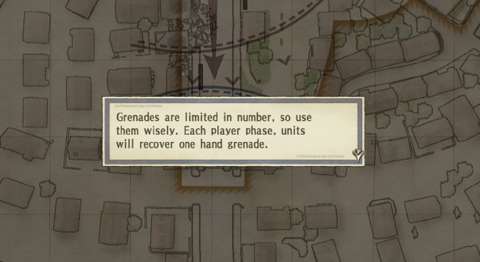
TOOLS & CONSUMABLES:
Every soldier class has at least one other device at their disposable, in addition to their main weaponry: the Ragnaid healing device. This means that if the player chooses to expend the CPs for his/her continued survival, a footsoldier can always have a chance at staying alive a bit longer.
It is also worth noting here that despite the lore behind them which implies that a soldier can run out of such devices, a soldier will not run out of them during any combat operation. On the other hand, using the device means using up the soldier’s attack allowance.
Most soldier classes, with the exception of the Lancer and Sniper, have grenades. These are mainly used to force an enemy out of cover, if he is not killed outright by the grenade. Grenades have rather small blast radii, however, which can seem a bit odd to veterans of war-themed games. For reasons of gameplay convenience, soldiers regain their grenades by their side’s next turn.
Lance rockets are replenished at a rate of one rocket per turn when the lancers are away from camps. This is a limitation to keep in mind if the player is trying to advance lancers into better firing positions against enemy tanks.
THE EDELWEISS & THE SHAMROCK:
As mentioned earlier, Welkin’s combat unit includes a tank, namely the legendary over-engineered prototype tank, the Edelweiss. It is later joined by the Shamrock, a hybrid Gallian tank which is also made of scavenged Imperial tank parts.
It has to be said here first that there will not be any heavy or super-heavy tank at the player’s disposal. However, the Edelweiss and Shamrock have enough armaments, if the player is looking for a power-trip (though it won’t be a satisfying trip; this will be explained later).
The Edelweiss out-performs almost any other tank, with the exception of one Imperial tank which has similar capabilities but which will not be mentioned further to prevent spoilers. If the player keeps up with the unlocking of upgrades for the Edelweiss, it can go toe-to-toe with just about any Imperial tank and come out on top.
The Shamrock is more of an infantry support vehicle than one that is made for armored warfare. Although it can mount a cannon for anti-armour purposes, its gun caliber will never reach that of the Edelweiss, making it sub-optimal for tank-versus-tank combat. For other roles, it has two other mutually exclusive options of main weapons: an array of autocannons and a massive flame-thrower.
The descriptions of both tanks would sound good on paper, but in practice, they are actually next-to-worthless, especially for the execution of A-rank/S-rank strategies. The problems which lead to this conclusion will be described shortly.
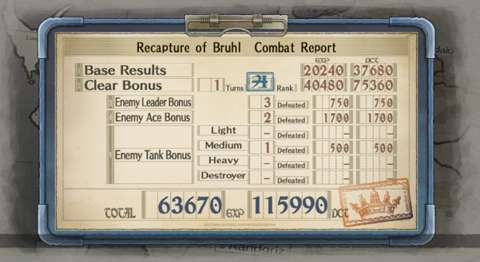
TWO COMMAND POINTS FOR USING A TANK:
A tank is a force-multiplier, so it is to be expected that the game’s developers would attempt to balance their use against the use of footsoldiers. This balancing measure comes in the form of the cost of two CPs to activate a tank, versus just one for footsoldiers.
This would have been understandable, if the performance of the tanks in areas other than firepower had been greater than that of footsoldiers. Unfortunately, this is not the case; the tanks have many drawbacks.
Chief of these are their lack of mobility, which will be elaborated further later. It will be said for now that the tanks’ problematic mobility makes them quite useless, because much of the gameplay is about positioning and maneuvering.
FRUSTRATION IN MOVING TANKS AROUND ENVIRONMENTAL OBJECTS:
The matter of inconsistencies in the navigation of environmental objects had been mentioned earlier. These make the movement of soldiers frustrating enough already, but they make the movement of the Edelweiss and Shamrock even more difficult to stomach.
Many things will block the movement of these tanks. Some are understandable, such as trenches, ramps and (indestructible) walls. The others are not so understandable: the tanks cannot rumble over certain piles of rubble, whereas they can crash into sandbags and certain walls without much of a problem. They are easily caught in certain environmental geometries, especially those of ramps, thus leading to a lot of action points being wasted in an attempt to dislodge them.
OPACITY IN CAMERA & CONTROL INPUT COMBINATIONS IN TURNING A VEHICLE:
The game’s manual and tutorials do include information on the basics of moving a tank around. However, neither does not exactly mention how the controls for its movement change according to the relative orientation of the camera with respect to the tank’s own orientation.
When the tank is perpendicular to the camera, pressing any movement button with a direction other than the direction of its apparent facing will cause the tank to turn in the direction of the movement button. The tank will complete this turn first before moving in that direction.
Furthermore, the tanks sometimes go haywire, jittering as they move along; the jittering will cause action points to deplete even faster, because the game registers the jittering as rapid turns. The cause of this is not clear, but it tends to happen if the player does not actively control the camera while trying to move the tanks about.

Learning about these problems the hard way can be unpleasant. Of course, there can be a counter-argument here that these control inputs are not that different from those for footsoldiers.
However, vehicles have the additional consideration of having to spend action points to turn, as mentioned already. Therefore, any attempt to manipulate the camera while moving a tank will inadvertently cause the loss of action points.
Unless dealing with the camera and tank movement is already second-nature to the player (something that can be achieved with doggedly stubborn practice), he/she will need to plot out a path for the tank, not unlike what has to be done for a connect-the-dots puzzle, and then move the tank in spurts along the path. Yet, this is just a work-around, not a solution.
SMOKE MORTAR:
The best reason to use the Edelweiss is its smoke mortar; this device is acquired halfway in the first playthrough. As its name suggests, it wreathes a large area in blinding smoke. The smoke prevents overwatch fire from any unit while he/she/it is caught in the smoke, and also disables almost every visual aid which would indicate the presence of enemies within the smoke.
This will be useful in a few scenarios, where footsoldiers will need to reach somewhere without getting shot to bits. Yet, one would wonder why there are no smoke grenades which can be deployed by footsoldiers. On the other hand, if there were any, the Edelweiss would have been rendered redundant.
ENEMIES:
For most of the game, the player will be facing Imperial soldiers; at least one campaign mission and one set of the DLC missions will have the player facing Gallian/faux-Gallian forces, but these enemies are hardly dissimilar from Imperial soldiers.
Imperial footsoldiers have the same types of gear and capabilities as the player’s own (sans potentials). Therefore, the player can expect enemy snipers to make long distance shots (often aiming for heads) and elite Imperial shocktroopers using their flamethrowers, among other examples of them acting out their battlefield roles.
However, they often fail to make good use of their non-class-specific equipment. For example, they do not make use of grenades to destroy cover so that their comrades would have an easier time dealing with the player’s soldiers; instead, they only use grenades if the player made the mistake of bunching up his/her soldiers. They also do not appear to use Ragnaid.
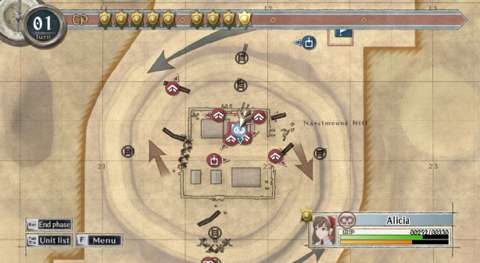
One of the defining features of Imperial footsoldiers is their massive headgear. Their headgear does not protect them; rather, it increases the size of the hitbox of their heads. Most players would eventually figure out that going for headshots is more efficient than shooting anywhere else.
ENEMY TANKS:
The Imperials are described in-game as being particularly enamored of armored fighting vehicles. This is very much reflected in the actual gameplay; the player will be facing a gamut of tanks. They would actually be more interesting than the Imperial footsoldiers, because each class of tank appears to have its own idiosyncrasies.
The player will encounter light tanks first; they follow most of the general characterization of tanks, e.g. limited front-facing overwatching-firing arcs. Next, there are the medium tanks, which have overwatch arcs which face their rear instead, thus making them a lot more difficult to flank.
Eventually, the player faces the heavy tanks, which are immense vehicles that can block entire alleys and can do a serious number on the Edelweiss. They also have armored radiators, thus necessitating guns of greater anti-armor caliber if the player is considering flanking strategies.
There are a few other armored fighting vehicles, such as a tank destroyer, self-propelled guns and an armored personnel carrier, but these only ever appear in specific story-related combat operations.
STATIC DEFENSES:
Halfway into the story campaign, the Gallians will be on counter-offensive, taking back ground which they have lost. However, for all their haughtiness, the Imperials have the wisdom to fortify their rear-guard, and heavily so. There are machine-gun and cannon bunkers, and less-protected but no-less well-armed emplacements such as manned anti-tank cannons and gatling guns.
Most of these static defenses have weak spots which can be exploited to get rid of them quickly. For example, some bunkers have fuel canisters sitting in their rear, which can be destroyed to immediately remove them.
However, it is generally in the player’s interest to bypass static defenses entirely. After all, as long as nothing gets into their line of fire, enemy-held static defenses are not a threat.
INCOMING ENEMY ARTILLERY FIRE:
Quite a number of missions will have the player avoiding incoming mortar fire. It is not clear how the player would be able to know where it would land, but know he/she does. As the game would suggest, it is in the player’s interest to avoid being in its area of effect when his/her turn ends.
Some scenarios have artillery fire coming in because the player has let his/her soldiers be spotted by forward observers. This is actually not entirely bad news, because enemy artillery fire only occurs at the end of the opposing side’s turn. As long as the player can get his/her units well out of the area which would be bombarded, there would be no problem.
There are also scenarios where entire swathes of the map would be bombarded. These circumstances make such scenarios quite interesting, because the player will have to make sure that soldiers end their turns in trenches.
VALKYRIES:
There are a few superhuman characters in the game who are called “Valkyrur” in the English adaptation; these are, of course, the eponymous characters of the game.
However, considering the poor adaptation job in the English localization of Valkyria Chronicles, as has been described earlier, the term “Valkyrur” may well be the result of a mistranslation. Therefore, this review will refer to them as “Valkyries” instead.

For most of the game, a Valkyrie would act as a boss – an unbeatable one too. Rather, the player will need to complete another objective in order to force the Valkyrie to withdraw. This can pose quite a challenge, because most other enemies in the game can be taken out with deft strategy; a powered-up Valkyrie simply cannot.
(There is also a pseudo-Valkyrie character in the story-based campaign, but to describe this any further would be to include one too many spoilers; it should suffice to say that this character has capabilities similar to a Valkyrie, and whose source of power would be the basis for the second game.)
One of the DLC combat operations – which is included in the Steam package of the game, regardless – does place a Valkyrie under the player’s control. It would have been fun, if not for the fact that most of the DLC missions reuse maps which have already been seen in the campaign.
The first Valkyria Chronicles will also set a tradition of sorts regarding the use of Valkyries as playable units: they are only rarely involved in actual gameplay, and when they are, it is often for set-piece scenarios.
OFFICERS, ACES & BOSSES:
Some enemies are of a higher paygrade than the rest. This is depicted by their different colour scheme. For example, in the case of Imperial officers, their armor is coloured red and their helmets have different shapes. They are generally tougher, stronger and more capable at evasion than their lessers. There are also tanks which are graded higher than the regular versions.
It is usually in the player’s interest to eliminate officer-rank enemies as early as possible during an operation. After all, they are the main reason that the opposing side has more CPs than the player does, even though both sides have the same base amount of CP income.
Aces are even tougher and more capable at evasion than officers, and may be officers themselves too. They have their own names and weapons which are more powerful than those which are used by regular troops. If the player can eliminate them, they yield Imperial weapons which can be used by the player’s own soldiers. These weapons are not always better than their Gallian counterparts in every aspect, but they generally have better damage output in lieu of accuracy.
There are also bosses, which are usually one-of-a-kind enemies that are often the target objectives of the combat operations in which they appear. Interestingly, they cannot be targeted with offense-oriented orders.
LOUSY COMPUTER-CONTROLLED OPPONENT:
Valkyria Chronicles is a wholly single-player game. Therefore, the opposition is controlled by the computer, and its caliber is an important factor in the enjoyment of the gameplay. Unfortunately, the computer-controlled opponent is rather inept.
For example, it is incapable of figuring out the least dangerous paths for soldiers to move along without being caught by overwatch fire. Furthermore, its only apparent solution to deal with overwatch fire that would kill its soldiers is to simply have soldiers stop and end their turns when they come under fire; if it does not do this, chances are that the soldiers will just get themselves killed.
More often than not, it would be up to the unique conditions of every combat operation which provide the challenge that the player would want. Through these conditions, the computer-controlled opponent gains early advantages, namely the possession of many camps, more units and officers than the player has, and plenty of reserves. Unfortunately, it is just terrible at holding onto these advantages.
Granted, the computer-controlled opponent is not completely dumb. It is still capable of recognizing major mistakes on the player’s part. For example, if the player left the base camp undefended, it will certainly have a soldier make a bee-line to it in order to capture it. Furthermore, if the combat operation requires a certain character to stay alive, it will recognize moments when this character has been isolated and will attempt to concentrate fire on this character.

Yet, these occasions when the computer-controlled opponent would gain the upper hand only ever occurs if the player made blunders which are entirely his/her own fault. It will not be able to counter a more careful player.
HAZARDS:
Maneuvers and positioning are an important part of the gameplay, but the player will not have an easy time pulling them off. One of the reasons is that there are hazards in the battlefield which the player has to be mindful about.
Chief of these are mines. There are nooks and crannies, usually corners which a soldier has to move around, that are littered with mines. There are also entire minefields which are impossible to circumnavigate without clearing a path through them.
Speaking of which, there are a few ways to remove mines. The most basic of these is to have an Engineer go through them, disarming them one by one. This is of course not feasible if the Engineer would come under fire.
The other way is to simply trigger them with units which are resistant to explosive weapons. For example, Lancers, when they have obtained the highest blast-resistant armor upgrade, can run through minefields, triggering mines willy-nilly while getting tossed about. It is silly, but sort of effective.
Interestingly, tanks can also trigger anti-personnel mines, so clearing fields of such mines is one of their few good uses. However, only tanks can trigger anti-tank mines, so the player will have to resort to Engineers to safely remove them.
Some scenarios have objects which can be shot in order to trigger a collapse. The collapse inflicts instant death on anything it hits, but usually, these objects are intended to delay the movement of something large instead of being used as improvised weapons.
Finally, there are allergy-related personal potentials, which when triggered, causes specific terrain types to poison the soldiers who are allergic to them as long as they remain on top. This is another silly design, though it is one of few good reasons to consider switching up the team roster.
MID-MISSION SCENARIO ALTERATION:
There are some combat operations with special conditions which, when triggered, cause the circumstances of the mission to be altered. These are usually used to divide the progress of a mission into a few stages.
For example, early in the game, the protagonists have to conduct a rear-guard defense of a town. One of the objectives is to eliminate an enemy officer. Upon his elimination, the next stage of the mission occurs; the protagonists will be shifted over to another area of the map. They are restored to full health, but have to run another gauntlet of enemies, which include a tank.
These changes would keep a new player on his/her toes, but more experienced ones would plan for these changes; after all, there does not seem to be any variation in these changes.
MISSION PERFORMANCE:
Upon completing a combat operation, the player’s performance would be scored and rewarded. This is done in a manner which is simpler than one would think.

The first and foremost factor of consideration is the number of turns which had gone by. Fewer turns lead to a better ranking. Strategies which lead to A-rankings require the player to be well aware of the positions of enemies on the map, as well as any terrain which can be used to cover the otherwise risky advances of the player’s footsoldiers.
Yet, these strategies would reveal certain issues that might cause dissatisfaction. For one, it is very likely that A-ranking strategies will not make use of the tanks under the player’s command.
For example, in Chapter 12: “The Fight for Bruhl”, the A-ranking result requires the player to win in the very first turn. This can actually be done with just Rosie and Alicia, the former clearing the way for the latter. Neither tank is needed. Granted, Rosie and Alicia will have to be quite tricked out to be able to do this, but it would be a sadomasochistic player indeed who does not equip the primary Shocktrooper and Scout with the best of equipment.
The other factor of performance is any “target of opportunity” which the player has eliminated; these are, of course, the officers and aces which have been mentioned earlier. Regular troops do not count.
However, the rewards from eliminating officers and aces are a pittance when compared to the rewards from getting high-ranking performances. Perhaps this was intentional, i.e. the game-makers would prefer that the player focuses on completing objectives instead of being thoroughly murderous, but achieving high-ranking performances is actually easier than trying to have every enemy slain (if that is not the objective in the first place, of course).
“HEADQUARTERS” – OVERVIEW:
A few chapters into the first playthrough, the player is introduced to the “Headquarters” gameplay element. In the narrative of the game, this is the representation of the home-base of Welkin’s combat unit, situated in the capitol of Randgriz and the nearby Lanseal Military Academy.
Gameplay-wise, this is the interlude in between missions, during which the player can choose to spend experience points on upgrading his/her soldiers, spend “Ducats” (an in-game currency which is part of mission completion rewards) on improving their gear, having Welkin learn new Orders, change the combat unit’s roster and their gear, and unlocking additional missions by supporting the journalistic efforts of Irene Ellet, an embedded reporter. Even when the narrative suggests that Randgriz is in peril, the player can still access the Headquarters menu and its options.
All of the Headquarters’ gameplay designs are functional, but there is a minor issue that is pervasive among them: many of the options can be a tad slow to load. It would appear that the loading times are set to a minimum. Moreover, there is always a character that will talk to Welkin every time when the player accesses any option; this cannot be entirely skipped with just a single button press, but has to be hastily gone through with repeated skip-inputs if the player would rather not hear them out.
(On the other hand, the characters may say something different if some previously unavailable content has been unlocked, so the player might want to keep an ear out for these.)

COMMAND ROOM & ROSTER:
The “Command Room” is one of the first Headquarters options to be unlocked in the first playthrough. Through this option, the player can recruit additional members into Welkin’s combat unit, or in the case of the roster having already been filled out, switch out characters for other characters. To help the player make his/her selection, he/she can inspect any character’s statistics, especially their Personal Potentials. However, their Battle Potentials are obscured, for whatever reason.
This is also where the player can obtain replacement soldiers, if previous ones end up being killed. However, this also reveals a gap in the game’s story-telling: there is seemingly a lack of any narrative consequence for losing secondary characters.
Welkin would not seem to be reprimanded for letting soldiers die, and other than the death quotes (some of which accuse Welkin of incompetence), there does not appear to be any other form of emotional expression about the loss of secondary characters. (In fact, it would be up to the manga and anime adaptations of Valkyria Chronicles to fill in these gaps.)
As the player progresses through the story-based campaign, additional characters will be added to the roster; Eleanor Varrot makes an announcement whenever this happens. However, a few characters can only be obtained by fulfilling certain conditions.
Some of these conditions would be stumbled upon somewhat ‘naturally’, if the player is an ardent fan of the game, or a completionist. For example, one character is unlocked after the player has obtained 10 medals (more on these later), whereas another is unlocked after hoarding a large amount of Ducats.
Some other conditions have hints which are inserted into the documented profiles of certain other characters. For example, in the complete documented profile of a certain Karl Landzaat, his love interest, who is a certain Lynn, is mentioned; this indicates that Karl is key to unlocking Lynn as a playable character, though exactly how this is so would not be clear until the player either does research on Lynn, or unwittingly gets Karl knocked-out, but rescued later.
(Incidentally, when a player character’s profile has been completely filled-in, all of his/her Personal Potentials will have been revealed.)
Ultimately though, unlocking hidden characters would be something that an ardent fan of the game would enjoy. This is because the narrative of the game does not always appear to acknowledge the circumstances which led to the unlocking of the character. Returning to the example of Lynn, she does not appear to mention anything about Karl’s incapacitation when she enlists in Welkin’s unit.
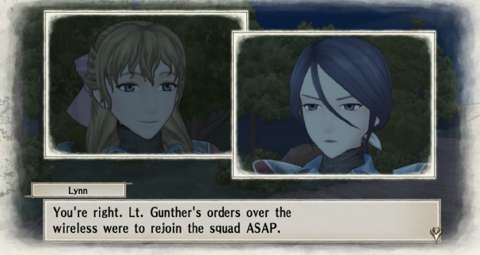
SQUAD BARRACKS:
The “Squad Barracks” is where the player can change the primary gear-piece of any footsoldier. For most soldiers, their primary gun is the only thing which can be switched around; for shocktroopers, their choice of gear is extended to include their flamethrower attachments after they reach elite status. The Squad Barracks is also where the player can check the descriptions of both Personal and Battle Potentials.
Unfortunately, the Squad Barracks will also reveal a deliberate limitation in the game: the player cannot see certain statistics of footsoldiers, such as their exact Accuracy and Defense ratings. These have to be obtained from wikis for the game, which in turn source the data from an official strategy guide which is published and sold by BradyGames.
TRAINING FIELDS:
The “Training Fields” is where the player spends experience points on levelling-up soldiers. It would not have been noteworthy in this review, if not for its presentation.
When the player makes a decision to spend experience points, the game will play out visuals and audio which shows the progress which the soldier classes are making towards their next level; the drill instructor will also make the same remarks over and over. These aesthetics cannot be entirely skipped or disabled. The player will need to mash on the skip button to hurry things along.
R&D FACILITY:
Welkin’s combat unit happens to have the support of some of Gallia’s military engineers and mechanics; this support is represented through the “R&D Facility”. In the narrative, these individuals make use of the inherited research notes of a certain Professor Theimer to craft gear upgrades and ground-breaking variants of weapons and equipment, all of which apparently gone into the hands of the 3rd militia regiment, of which Welkin’s unit is a part of.
Gameplay-wise, this is where the player goes to in order to purchase gear upgrades for the footsoldiers and the tanks. New upgrades will be unlocked as the player progresses in the first playthrough.
It is also worth mentioning here that any upgrades which the player purchases for footsoldiers will be automatically equipped on them. In the case of primary weapons, unless the player has set individual soldiers to have guns from specific weapon lines, the last upgrade which the player purchased for that soldier type will be applied to any soldier which has yet to be assigned a specific weapon.
The R&D Facility is also the place to go to in order to re-jigger the tanks’ modular parts. The parts are represented as simply-shaped jigsaw puzzle pieces which have to be fitted into a grid of limited space, so not all parts can be crammed into the tanks.
In practice, there is little need to do so for a player who prefers to use footsoldiers instead of the cumbersome tanks. However, there is at least one mission where the player will need to consider the configuration of the Edelweiss’s modular parts.

Like the other Headquarters options, the R&D Facility has an associated character which yaps the same lines over and over whenever the player makes a decision. It would have been better if this character made unique remarks about the player’s purchase decisions, but this is not the case.
CASTLEFRONT STREET:
In terms of narrative, Castlefront Street is where Welkin and friends meet with the embedded reporter, Irene Ellet, for interviews and to help fund her efforts to produce uncensored news on the war against the Imperial invaders.
Gameplay-wise, this is where the player spends Ducats in order to unlock optional story bits and missions. Chief of these are combat operations which are associated with the main characters, which reveal their motivations as well as unlock one of their personal potentials.
Other than that, the main function of this option is to yield lore on the political outlook of Europa, as well as what is happening elsewhere in Gallia.
CEMETERY:
Considering that there is a gameplay element of permanent death, one would think that the Cemetery option is a hall of shame of sorts for the player’s ineptitude at keeping soldiers alive, and where Welkin would go to pay his respects to people who died under his command. However, this is not the case in both narrative and gameplay terms.
The Cemetery is actually where Welkin meets a certain individual, who is evidently a war veteran and one who is well-versed in Orders. The player spends experience points here in order to add more Orders to Welkin’s repertoire.
AUDIENCE HALL:
After some time into the story, Welkin obtains the attention and favour of the ruler of Gallia, the young but taciturn Archduchess Cordelia.
When this happens in the first playthough, the “Audience Hall” option is unlocked in the Headquarters menu. In terms of narrative, Welkin receives commendations from his commanding officer, Eleanor Varrot, and through these, he receives awards from the Archduchess.

Gameplay-wise, good performance in combat operations lead to other rewards in addition to the experience points, ducats and captured weapons that the player would get from completing them. These other rewards are obtained via the “Audience Hall” option.
Some of these rewards are medals, through which the player clinches certain Achievements. The more practical rewards are the weaponry in the palace’s armoury. One would think that these gaudy-looking weapons are not combat-worthy, but they tend to be better than the regular Gallian weaponry at the time, and they are often more accurate than Imperial weapons of the same time too.
Like the other Headquarters options, the player will have to mash the skip-button through the same voice-overs that he/she would listen every time he/she drops by the Audience Hall. These would have been more entertaining if Cordelia and Welkin had made specific remarks about the missions which the latter has completed, but this is a missed opportunity.
BOOK MODE:
The “Book Mode” is actually the first gameplay feature which the player encounters after the intro cutscene. In the player’s first playthrough, there is initially nothing much which can be done with it, other than to play the next cutscene, dialogue or combat operation which is unlocked.
Later, the Book Mode gains more options. The player can turn the “pages” of the book which represents the mode, switching over to menus which are associated with other gameplay features. For example, there is a book ‘section’ which shows the skirmish missions which the player can initiate. There is also another which has in-game documentation about the characters in the story and lore about the setting of Europa.
Incidentally, the texts for this documentation are far better written than the atrocious lines for the English voice-overs.
It can take a while for a computer-centric user to learn how to use the keyboard to navigate through the Book Mode. This is because Book Mode lacks any mouse support, even though it looked like it could have benefited from it, e.g. the player could have been able to click on pictures to play episodes.
DLC – EDY’S CHALLENGE PACKS:
There are many characters in Valkyria Chronicles, and it so happens that Sega has a habit of showcasing just about every character in order to gauge their potential popularity among its customers/followers. Edy, an aspiring celebrity wanna-be, so happens to top the polls.
In fact, Edy and her closest squad-mates have been chosen to be the stars of two DLC packages. One of these is a one-shot scenario that is about how they managed to bungle up and become separated from Welkin’s combat unit, and the other is a series of scenarios which have the player utilizing specific classes of soldiers more than the others.
The one-shot scenario contains perhaps the cheesiest, campiest and silliest story-telling to be seen in the game. If the player can look past this though, the scenario does offer some challenge, such as enemy reinforcements which appear very close to the zone which Edy and pals must defend.
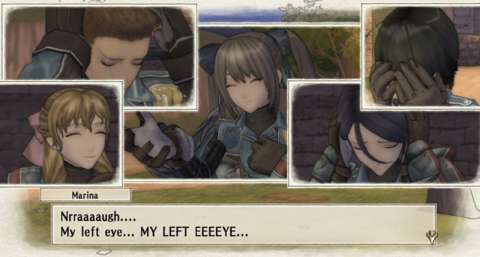
The aforementioned series of scenarios are built into the game as an additional set of skirmishes which can be accessed via Book Mode. Of the six scenarios, five are associated with the soldier classes, one for each class.
The main draw of these scenarios are the rewards which they offer upon completion, and after eliminating the Aces in these scenarios. The rewards include high-end Imperial weaponry, which are usually only found in the Hard and Expert variants of skirmishes.
However, where a scenario has two Imperial weapons to offer, it can only put forth one as a reward upon completion, thus requiring repetition of the scenario. For example, the Lancer Challenge must be played twice to claim its unique rewards: once, to unlock the default and one-time only reward of an Imperial lance, and again, to steal a sniper rifle from the enemy Ace in this challenge.
The final Edy Detachment challenge is a mission which requires the player to use the Edelweiss. Cunning players would notice that they will need to resort to aggressively advancing the Edelweiss in order to obtain an A-rank performance, something which cannot be done without changing the Edelweiss’s parts to a certain configuration just to deal with certain hazards.
VISUAL DESIGNS – OVERVIEW:
Valkyria Chronicles was a pretty game when it came out in 2008 on the PS3. Years on, some of its luster may no longer seem impressive, especially when it has been ported to the computer platform.
Furthermore, there does not appear to have been much of any visual improvement; textures appear to have remained the same, though things such as hair are now more vibrantly animated, sometimes unbelievably. However, its stylized presentation does go some way to mask its age; there is a graphical filter which has been applied on everything seen in the game such that it looks like it has been coloured with pencils.
There are other visual designs which stood out in the PS3 version, and still stands out in the PC one too.
VISUAL DESIGNS – POSTURES & ANIMATIONS FOR SOLDIER CLASSES:
Characters which belong to the same class of soldiery will noticeably have the same set of postures and the same set of animations. The game will randomly pick one from each set whenever these are to be shown, but astute players will eventually notice the repetition.
Of course, the game does try to explain this: the drill instructor of the training field will mention that every soldier of the same class will be trained in the same way as the others, whether he/she likes it or not.
It has to be mentioned here that the postures of certain character classes do actually affect gameplay. For example, Lancers have a bad habit of standing upright in a regal posture. This, of course, makes them easy to spot and hit compared to the other classes.

VISUAL DESIGNS – WEAPONRY AND OTHER HARDWARE:
Aficionados of World War I and II will notice the familiarity of most of the wargear in the game. They are based on nascent 20th century technology, such as the squat and bulky tanks which resemble those that were built in the first half of that century. Most of the firearms, especially the automatic ones, would seem familiar too. For example, there are a number of firearms with barrels which resemble the large water-cooled cylinder that is used for the Maxim machine-gun.
However, authenticity does not appear to the priority of the game’s artists. For example, the engineer’s unique tool appears to resemble a wire-cutter, even though there are no barbed-wire fences in the game. Moreover, the engineer is using this tool to repair tanks and disarm mines, which is certainly not what a real-world wire-cutter is for.
Then there are the more outlandish things, such as the anti-armor lances. Fans would speculate that they are spring-operated weapons, not unlike the WWII PIAT, but it is more likely that the weapons are the result of artistic liberty on the part of the game-makers, especially considering that the lore of the lances mentioned that they are styled after medieval lances.
Next, there are, of course, the fantastical weapons which are used by the superhuman Valkyries. These gave the game-makers an excuse to include a lot of particle effects in the game, especially in this remake. Ultimately though, the player will be seeing these more often in the cutscenes than during actual gameplay.
VISUAL DESIGNS – SHOOTING ANIMATIONS FOR CHARACTERS:
Footsoldiers and tanks (and a Valkyrie) will perform animations when they attack; this is not just for looks, as it tends to be in other turn-based strategy games. Keeping this in mind is of particular importance when dealing with overwatch fire from enemies. If a footsoldier who is under control of a player can get behind cover before enemies start their firing animations, he/she would be safe; said enemies will also reset their animations, returning to their default pose.
VISUAL DESIGNS – TARGET MODE VISUAL AIDS:
When the player uses the targeting mode, there are a few visual aids to help the player figure out whether a shooting attempt might work out. For example, the targeting reticle’s circumference will change colour if the shot that would be fired is likely to hit an enemy.
Unfortunately, the user-friendliness of the visual aids is incomplete. This is particularly the case for visual aids which are associated with indirect-fire weapons. For example, the game lacks any indicator of how far the explosion of a mortar shell or grenade would reach.
As another example, there is an arc which shows the trajectory of the ordnance/grenade, but the arc can be obscured by obstacles, thus reducing their efficacy as indirect-fire weapons. One could argue that this is a believable limitation, but there had been other turn-based strategy games, such as the reboot XCOM games, which show where a grenade would land after being thrown over obstacles.

VISUAL DESIGNS – MAPS:
Valkyria Chronicles is a strategy game which has the player minding over a battlefield, so it is expected that the player would be looking at maps in order to better plan and execute his/her strategies with.
Unfortunately, the visual designs for the maps are at times a matter of style over practicality. The maps which are shown during briefings look like the vellum maps of yore, which is a nice aesthetic touch, but the details which show the topography of terrain lack contrast against other details. Fortunately, the maps which the player sees in Command Mode are much clearer; this has been mentioned earlier.
When the player is controlling a unit, he/she is given a mini-map that shows the boundaries of the level and the general locations of friendlies and spotted enemies. Unfortunately, it is sparse on any other details, and is generally not very useful for large maps. (The on-screen size of the mini-map remains the same regardless of the actual size of the levels.)
VISUAL DESIGNS – CHARACTER MODEL DETAILS:
There is an incredible amount of detail in the models of characters. The best example of these is Prince Maximilian’s full regalia, which can be seen in the last few chapters of the game; there is so much bling on his ceremonial uniform that one would wonder how many hours had gone into its design.
Observant players may notice that the same model would be used for multiple named characters, especially if they are of the same class. There are small variations in their models, such as any trophies or bling that certain characters might include on their uniforms. Their heads are, of course, the main way to differentiate between these characters. (The main characters do have models that are noticeably different from other characters who happen to be of the same class though.)
Interestingly, within the player’s combat unit, different characters have different heights, even if they are of the same soldier class. For example, when Largo and Jann – both of whom are Lancers – stand next to each other, Largo is noticeably taller.
Such differences would not have been noteworthy, if not for the fact that the hitboxes of character models are dependent on their physical statures. Therefore, in the case of the example above, Largo will find taking advantage of cover or obscuring obstacles to be a bit more difficult.
Fortunately, the game’s designers appeared to have taken this into consideration. For example, most walls and small hills are taller than the tallest character in the player’s combat unit, so tall characters are not always disadvantaged.
VISUAL DESIGNS – RAGDOLLING:
Unfortunately, not all of the game’s visual designs are impressive or excusable. Some of its worst visual designs can be seen when a footsoldier gets knocked out.
In the case of most footsoldiers with defined classes, their models are subjected to ragdolling when they are knocked out. The result is usually bizarre and silly, for they would be often thrown up into the air. They will flop down onto the ground with their limbs and sometimes torsos contorted in silly ways, if they are not flailing or even worse, spasming.
Sometimes, the game will despawn and respawn their bodies with more believable postures, but this does not always occur.
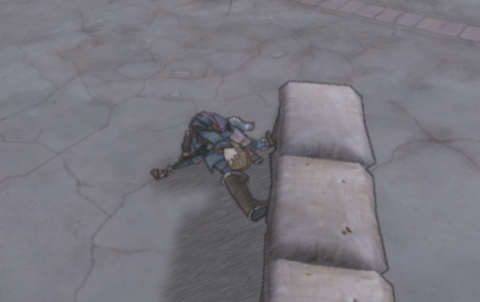
Interestingly, Selvaria Bles, who is an antagonist in the main campaign and the protagonist of a DLC package, is not subjected to ragdoll animations when she gets knocked out.
(Note: It should be said here though that this reviewer deliberately let Selvaria Bles die from concentrated gunfire, in order to see whatever animations that would arise from this. It is actually quite difficult to have her killed, even in her unpowered form.)
AUDIO DESIGNS:
The audio designs of the game are more convincingly impressive than its visual or gameplay designs.
The music, in particular, is the first thing which the player hears from the game. Composed by Hitoshi Sakimoto, the music is mainly orchestral, which is perhaps fitting, considering that the game is Sega’s take on World War I and a bit of the second war as well. The soundtracks are limited though, and certainly are fewer in number compared to the number of scenes in the story. Eventually, they would sound all too familiar, especially after the player has gone into “New Game Plus”.
There are many individual characters in the game, and not as many voice-actors and –actresses to give each one a truly unique voice in both the Japanese and English voice-overs. Still, the scene directors did a good enough job to avoid having two characters that sound too similar to each other from appearing within the same scene.
Amusingly, every named character has his/her own lines to say during specific situations which can happen to any of them. For example, a Personal Potential may be possessed by several people, but each person has different things to say when it is triggered.
For example, Cezary the Sniper has something to say about the hair of the Darcsen people when his “Darcsen Hater” potential triggers, whereas Theold the Lancer says something about them bringing misfortune onto others when that potential triggers for him.
These are some of the few ways in which secondary characters are able to express themselves with. Otherwise, they have little else to say, especially about the progression of the story.
Story-related combat operations often have main characters uttering lines which are unique to these operations over the radio. For example, in a certain combat operation which concerns Varrot’s personal agenda, she can be heard making rather angry remarks about the enemies which the player has to eliminate.
Most of the sound effects sound like they have been taken from stock libraries, such as the familiar sound of bombs whistling through the air. Other sound effects include clearly artificial noises, such as the chimes which can be heard whenever a critical hit is landed and the crackles which are associated with Ragnite weaponry.
Of these sound effects, the gunfire for weaponry which can fire overwatch shots is particularly important, because the player will need to be able to recognize what weapons are threatening a footsoldier which is under the player’s control. Fortunately, most of these weapons sound differently from each other.

NEW GAME PLUS:
After finishing the first playthrough, the player can choose to start a new playthrough with gameplay data from the first. To be specific, the player retains any remaining experience points and ducats, soldier class levels, captured Imperial gear, Gallian gear upgrades, awarded royal-class gear and Personal Potentials which have been unlocked among named soldiers.
Any named soldiers who were in the combat unit’s roster by the end of the previous playthrough will also have all their Potentials unlocked and their documented profiles completely filled in too; in particular, what they did in the aftermath of the story will be shown. Any soldiers who died will return in the “New Game Plus” playthrough too.
As for additional gameplay content, one hidden character will be revealed, and the last Order to be learned via the Cemetery option will become available. Finally, the Hard and Expert difficulty settings for the regular skirmish operations will be unlocked; these are some of the toughest battles in the game.
LADDER GLITCHES:
Unfortunately, the port from the PS3 over to the PC has not been entirely without problems.
There is a rare glitch which affects one of the two maps which take place at the Ghirlandaio fortress, a place that would be the setting of some of the last chapters in the story.
In this map, there are ladders which lead up onto the battlements of the fortress. Some of these ladders are bugged in the PC version of the game. Upon using them, the player character will clip through the ground and fall under the map. A nearby screenshot shows an example of the occurrence of this glitch.
This glitch renders any strategic plan which involves the bugged ladders quite useless. Considering that the battlements are some of the best places for a footsoldier to move along without being subjected to overwatch fire from anywhere other than the battlements, this glitch can be a serious problem.
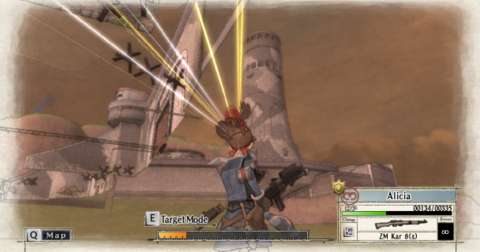
GOOD OVERARCHING STORY, UNCONVINCING SCENE DIRECTION:
The final complaint to be made about the game is how the writers filled in the plot details after the overall story progression has been set.
After a discerning player has played and experienced the entirety of the story, he/she might be satisfied with the over-arching story of victors writing history and love blooming in war, among other themes that an experienced story-goer would notice. However, he/she would raise an eyebrow or two over how some scenes are acted out.
One of these less-convincing scenes occur halfway in the game. An important character dies from an ambush, which should not have happened since the protagonists are supposed to have secured the area which they are in. Furthermore, the area should have been highly defensible, since there is only one path leading into it and it is bordered by high cliff walls. Yet, the ambush came from that very path, which the protagonists should have guarded if they have any strategic sense as soldiers should.
This scene would have been more palatable if the character died due to an attack which is more covert or stealthy, but this is not the case.
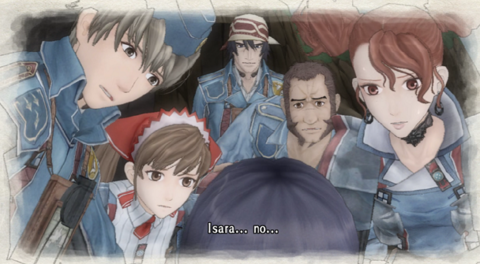
There is also another eyebrow-raising scene which occurs at the very finale, when one character sacrifices himself so as to make certain that another dies. This is nothing controversial in itself of course, but the circumstances in this scene might seem unbelievable, such as the presence of a pit which conveniently leads to a weak spot in a massive war machine.
SUMMARY:
There is actually a great overarching story to be had from the game; if one is to read the synopsis of story, it would seem epic and romantic. Unfortunately, the scene-by-scene execution is campy, and the English adaptation is even worse because of problems such as the inclusion of extraneous remarks. There are also some narrative gaps, which the sequels do not appear to address, such as why the Valkyries chose to breed with the local people of Europa after they have invaded it, thus diluting their powerful bloodline.
Small but not crippling issues of user-friendliness abound in the game, ranging from incomplete visual aids to reserving gameplay information behind separately price-tagged products (namely an official strategy guide). The most pervasive problem is the lack of any facility to skip dialogues which occur during combat operations. Fortunately, the game’s most important piece of documentation, the manual, is free to download, though it is by no means a thorough documentation of the game.
Valkyria Chronicles is a flawed gem, much in need of polish but otherwise still brilliant enough to have an attractive shine.
(It remains to be seen what Sega would do with the main line of the series. After all, there has been a less-than-successful offshoot that is the trading card game, the latest title to carry the word “Valkyria” is not a turn-based strategy game and the two sequels are PSP titles, which will not be easy to re-market on the PC or PS4 without complete remakes.)
